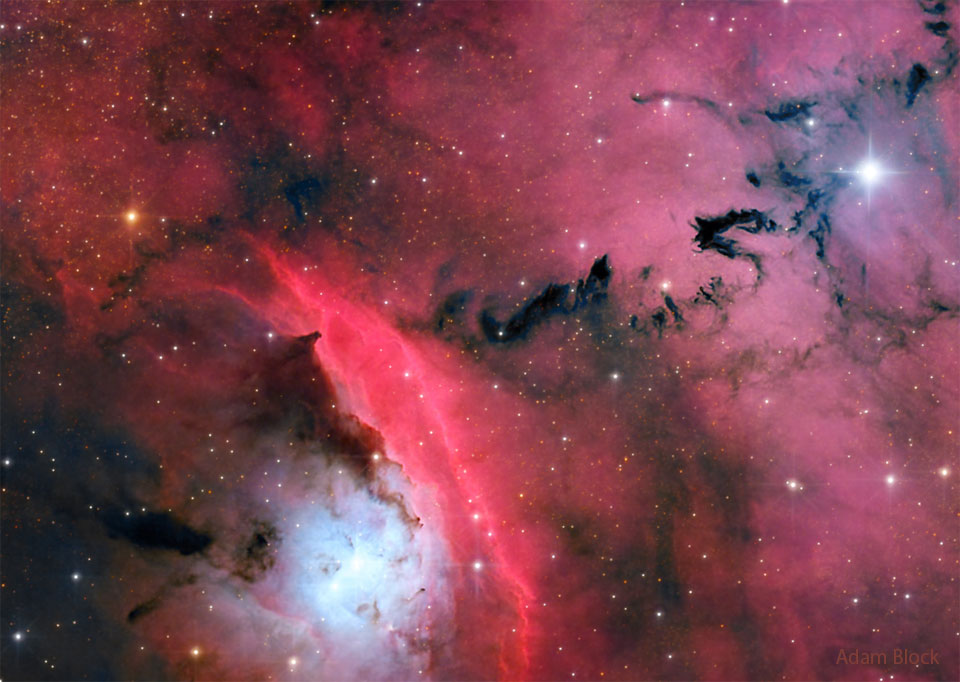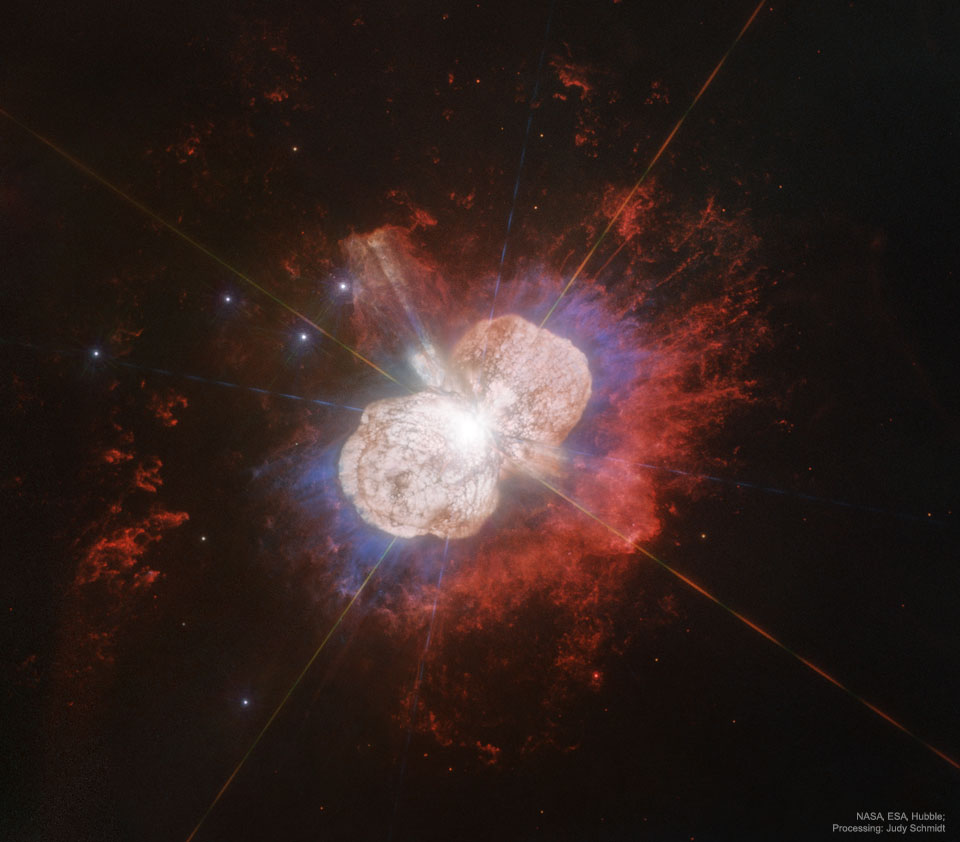Blog
NGC 6559. Visible in the featured image are red glowing emission nebulas of hydrogen, blue reflection nebulas of dust, darkabsorption nebulas of dust, and the stars that formed from them. The first massive stars formed from the dense gas will emit energetic light and winds that erode, fragment, and sculpt their birthplace. And then they explode. The resulting morass can be as beautiful as it is complex. After tens of millions of years, the dust boils away, the gas gets swept away, and all that is left is a bare open cluster of stars.

Oscar Emilio León Somoza (born July 11, 1943), known as Oscar D’León, and affectionately called The Pharaoh of Salsa, The Lion of Salsa, and the World’s Sonero, is a Venezuelan musician and bassist best known for his work with salsa music. He is the author of “Llorarás”, which he recorded in 1974 with his group, Dimensión Latina. He is also ambassador for Operation Smile.
more...Terry Garthwaite (July 11th 1938) is an internationally known singer, songwriter, composer, producer, and teacher. Her recording career dates back to the late 1960s when she and Toni Brown formed the rock group Joy of Cooking. She recorded several albums with the band, and then a dozen others by herself or in collaboration with other jazz and blues musicians.
Terry has also produced recordings by other artists including Jasmine, Rosalie Sorrels, Rhiannon, Nicholas, Glover &Wray, Hunter Davis, Robin Flower, and Ferron, whose Garthwaite-produced Shadows on a Dime was awarded four stars by Rolling Stone.
In performance she has shared the stage with such artists as BB King, Janis Joplin, Bonnie Raitt, The Band, Allen Ginsberg, Santana, Rosalie Sorrels and writer Bobbie Hawkins at venues that include Carnegie Hall, the Joseph Papp Theater, the Hollywood Bowl, and Canadian Folk Festivals.
Terry’s recent recordings and writing reflect an awareness of the healing nature of music. In 1992 she recorded her critically acclaimed Affirhythms – rhythmic affirmation chantsongs, and followed it in 2000 with Sacred Circles, songs of hope and heart.
In 2006, Terry began collaborating again with Toni Brown to put together a Joy of Cooking compilation. They pored through old tapes of live performances and studio forays–from their earliest beginnings in 1968–to find the best material with the best performances. The result is the double CD “Back to Your Heart”, one disc of studio takes of never-released songs, and the other a live Berkeley concert from the early ’70s.
She’s published a book, Joy of Sound – Explorations in Awareness Through Sound and Song, that includes vocal games/exercises and a CD of chants, as well as a couple of small books of Alliterhythms–pithy positive songs and sayings in alliteration. Most of her songs are available in her songbooks.
Terry’s music is an array of songs and sounds that encourages empowerment and delight, and radiates the healing nature of music. She currently leads vocal retreats, drum circles, and classes in singing together, playing with sound, and digging the musical garden.
The NASA/ESA Hubble Space Telescope has captured a monster in the making in this observation of the exceptional galaxy cluster eMACS J1353.7+4329, which lies about eight billion light-years from Earth in the constellation Canes Venatici. This disturbed collection of at least two galaxy clusters is in the process of merging together to create a cosmic monster, a single gargantuan cluster acting as a gravitational lens. Gravitational lensing is a dramatic example of Einstein’s general theory of relativity in action. A celestial body such as a galaxy cluster is sufficiently massive to distort spacetime, which causes the path of light around the object to be visibly bent as if by a vast lens. Gravitational lensing can also magnify distant objects, allowing astronomers to observe objects that would otherwise be too faint and too far away to be detected. It can also distort the images of background galaxies, turning them into streaks of light. The first hints of gravitational lensing are already visible in this image as bright arcs which mingle with the throng of galaxies in eMACS J1353.7+4329. The data in this image are drawn from an observing proposal called Monsters in the Making, which used two of Hubble’s instruments to observe five exceptional galaxy clusters at multiple wavelengths. These multi-wavelength observations were made possible by Hubble’s Wide Field Camera 3 and Advanced Camera for Surveys. The astronomers behind these observations hope to lay the groundwork for future studies of vast gravitational lenses with next-generation telescopes such as the NASA/ESA/CSA James Webb Space Telescope. [Image Description: A cluster of elliptical galaxies, visible as a dense crowd of oval shapes, each glowing orange around a bright core. Right of the largest, central galaxy, a background galaxy is stretched into two connected, thin arcs by the cluster’s gravity. Various other galaxies are dotted all around, a few being small spirals.

more...
Arlo Davy Guthrie (born July 10, 1947) is an American folk singer-songwriter. He is known for singing songs of protest against social injustice, and storytelling while performing songs, following the tradition of his father, Woody Guthrie. Guthrie’s best-known work is his debut piece, “Alice’s Restaurant Massacree“, a satirical talking blues song about 18 minutes in length that has since become a Thanksgiving anthem. His only top-40 hit was a cover of Steve Goodman‘s “City of New Orleans“. His song “Massachusetts” was named the official folk song of the state, in which he has lived most of his adult life. Guthrie has also made several acting appearances. He is the father of four children, who have also had careers as musicians.
Guthrie was born in the Coney Island neighborhood of Brooklyn, the son of the folk singer and composer Woody Guthrie and dancer Marjorie Mazia Guthrie. He is the fifth, and oldest surviving, of Woody Guthrie’s eight children; two older half-sisters died of Huntington’s disease (of which Woody also died in 1967), an older half-brother died in a train accident, another half sister died in a car accident, and a fourth sister died in childhood. His sister is the record producer Nora Guthrie. His mother was a professional dancer with the Martha Graham Company and founder of what is now the Huntington’s Disease Society of America. Arlo’s father was from a Baptist family of English and Scottish descent; and his mother was Jewish, the daughter of immigrants from Ukraine. His maternal grandmother was Yiddish poet Aliza Greenblatt,
more...Béla Anton Leoš Fleck (born July 10, 1958) is an American banjo player. An acclaimed virtuoso, he is an innovative and technically proficient pioneer and ambassador of the banjo, bringing the instrument from its bluegrass roots to jazz, classical, rock and various world music genres. He is best known for his work with the bands New Grass Revival and Béla Fleck and the Flecktones. Fleck has won 15 Grammy Awards and been nominated 33 times.
In 2020, he was inducted into the International Bluegrass Music Hall of Fame as a member of New Grass Revival.
A native of New York City, Fleck was named after Hungarian composer Béla Bartók, Austrian composer Anton Webern, and Czech composer Leoš Janáček. He was drawn to the banjo at a young age when he heard Earl Scruggs play the theme song for the television show Beverly Hillbillies and when he heard “Dueling Banjos” by Eric Weissberg and Steve Mandell on the radio. At the age of 15, he received his first banjo from his grandfather. During the train ride home, a man volunteered to tune the banjo and suggested he learn from the book How to Play the Five String Banjo by Pete Seeger. He attended the High School of Music & Art in New York City, playing French horn until he flunked and was transferred to the choir, though he spent most of his time on the banjo. He studied the book Bluegrass Banjo by Pete Wernick and took lessons from Erik Darling, Marc Horowitz, and Tony Trischka.
more...Edward Lee Morgan (July 10, 1938 – February 19, 1972) was an American jazz trumpeter and composer.
One of the key hard bop musicians of the 1960s, Morgan came to prominence in his late teens, recording on John Coltrane‘s Blue Train (1957) and with the band of drummer Art Blakey before launching a solo career. Morgan stayed with Blakey until 1961 and started to record as leader in the late ’50s. His song “The Sidewinder“, on the album of the same name, became a surprise crossover hit on the pop and R&B charts in 1964, while Morgan’s subsequent recordings found him touching on other styles of music such as post-bopand avant-garde jazz as his artistry matured. Soon after The Sidewinder was released, Morgan rejoined Blakey for a short period. After leaving Blakey for the final time, Morgan continued to work prolifically as both a leader and a sideman with the likes of Hank Mobley and Wayne Shorter, becoming a cornerstone of the Blue Note label.
Morgan died at the age of 33 when his common-law wife Helen Morgan shot and killed him following a confrontation at Slugs’ Saloon, in New York City.
Edward Lee Morgan was born in Philadelphia, Pennsylvania, United States, on July 10, 1938, the youngest of Otto Ricardo and Nettie Beatrice Morgan’s four children.
more...Charles Melvin “Cootie” Williams (July 10, 1911 – September 15, 1985) was an American jazz, jump blues, and rhythm and blues trumpeter.
Born in Mobile, Alabama, Williams began his professional career at the age of 14 with the Young Family band, which included saxophonist Lester Young. According to Williams he acquired his nickname as a boy when his father took him to a band concert. When it was over his father asked him what he’d heard and he replied, “Cootie, cootie, cootie.”
In 1928, he made his first recordings with pianist James P. Johnson in New York, where he also worked briefly in the bands of Chick Webb and Fletcher Henderson. Williams rose to prominence as a member of Duke Ellington‘s orchestra when the band was playing at the Cotton Club, with which he first performed from 1929 to 1940. He also recorded his own sessions during this time, both freelance and with other Ellington sidemen. Williams was renowned for his “jungle”-style trumpet playing (in the manner of Ellington’s earlier trumpeter Bubber Miley and trombonist Joe “Tricky Sam” Nanton) and for his use of the plunger mute. He also sang occasionally, a notable instrumental feature being in the Ellington piece “Echoes of the Jungle”.For him, Duke Ellington wrote ”Concerto for Cootie,” which when lyrics were added became “Do Nothing till You Hear from Me“. He was also the soloist in other Ellington compositions, such as “Echoes of Harlem“, “Harlem Air Shaft“, and the religious piece ”The Shepherd Who Watches Over the Night Flock”, which was dedicated to the Rev. John Gensel.
more...Major “Mule” Holley Jr. (July 10, 1924 – October 25, 1990) was an American jazz upright bassist.
Holley was born in Detroit, Michigan, United States. He attended the prestigious Cass Technical High School in Detroit. Holley played violin and tuba when young.
more...Milton Brent Buckner (July 10, 1915 – July 27, 1977) was an American jazz pianist and organist, who in the early 1950s popularized the Hammond organ. He pioneered the parallel chords style that influenced Red Garland, George Shearing, Bill Evans, and Oscar Peterson. Buckner’s brother, Ted Buckner, was a jazz saxophonist.
Milton Brent Buckner was born in St. Louis, Missouri. His parents encouraged him to learn to play piano, but they both died when he was nine years old. Milt and his younger brother Ted were sent to Detroit where they were adopted by members of the Earl Walton band: trombonist John Tobias, drummer George Robinson fostered Milt and reedplayer Fred Kewley (né Fred Cecil Kewley; 1889–1953) fostered Ted.Buckner studied piano for three years from the age 10, then at 15 began writing arrangements for the band, he and his brother going on to become active in the Detroit jazz world in the 1930s.
more...Blind Boy Fuller (born Fulton Allen, July 10, 1904 – February 13, 1941) was an American blues guitarist and singer. Fuller was one of the most popular of the recorded Piedmont bluesartists, rural African Americans, along with Blind Blake, Josh White, and Buddy Moss.
Allen was born in Wadesboro, North Carolina, United States, one of ten children of Calvin Allen and Mary Jane Walker. Most sources date his birth to 1907, but the researchers Bob Eagle and Eric LeBlanc indicate 1904. After the death of his mother, he moved with his father to Rockingham, North Carolina. As a boy he learned to play the guitar and also learned from older singers the field hollers, country rags, traditional songs and blues popular in poor rural areas. Fuller underwent a suprapubic cystostomy in July 1940, probably due to the urethral stricture noted on Fuller’s death certificate, a narrowing or blockage of the urethra which can be caused by syphilitic chancres, infections from gonorrhea, or chlamydia, but continued to require medical treatment. He died at his home in Durham, North Carolina, on February 13, 1941. The cause of death was pyemia, due to an infected bladder, gastrointestinal tract and perineum, plus kidney failure.
more...Eta Carinae may be about to explode. But no one knows when – it may be next year, it may be one million years from now. Eta Carinae‘s mass – about 100 times greater than our Sun – makes it an excellent candidate for a full blown supernova. Historical records do show that about 170 years ago Eta Carinae underwent an unusual outburst that made it one of the brightest stars in the southern sky. Eta Carinae, in the Keyhole Nebula, is the only star currently thought to emit natural LASER light. This featured image brings out details in the unusual nebula that surrounds this rogue star. Diffraction spikes, caused by the telescope, are visible as bright multi-colored streaks emanating from Eta Carinae’s center. Two distinct lobes of the Homunculus Nebula encompass the hot central region, while some strange radial streaks are visible in red extending toward the image right. The lobes are filled with lanes of gas and dust which absorb the blue and ultraviolet light emitted near the center. The streaks, however, remain unexplained.

Haydée Mercedes Sosa (American Spanish: [meɾˈseðes ˈsosa]; 9 July 1935 – 4 October 2009), sometimes known as La Negra (lit. ’The Black One’, an affectionate nickname for people with a darker complexion in Argentina), was an Argentine singer who was popular throughout Latin America and many countries outside the region. With her roots in Argentine folk music, Sosa became one of the preeminent exponents of El nuevo cancionero. She gave voice to songs written by many Latin American songwriters. Her music made people hail her as the “voice of the voiceless ones”.
Sosa performed in venues such as the Lincoln Center in New York City, the Théâtre Mogador in Paris and the Sistine Chapel in Vatican City, as well as sell-out shows in New York’s Carnegie Hall and the Roman Colosseum during her final decade of life. Her career spanned four decades and she was the recipient of six Latin Grammy awards (2000, 2003, 2004, 2006, 2009, 2011), including a Latin Grammy Lifetime Achievement Award in 2004 and two posthumous Latin Grammy Award for Best Folk Album in 2009 and 2011. She won the Premio Gardel in 2000, the main musical award in Argentina. She served as an ambassador for UNICEF.
more...John Graham Mitchell (9 July 1946 – 12 November 2008) was an English drummer and child actor, who was best known for his work in the Jimi Hendrix Experience for which he was inducted into the Rock and Roll Hall of Fame in 1992. He was inducted into the Modern Drummer Hall of Fame in 2009.
Mitchell was born in Ealing, Middlesex, to Phyliss C (née Preston) and Thomas J Mitchell on 9 July 1946 (although several modern sources have incorrectly claimed that he was born in 1947). As a twelve year old, he had a leading role in the British film Bottoms Up (1960) with Jimmy Edwards. As a teenager he starred in a children’s television programme, Jennings at School and also had a bit part in the 1963 film Live It Up! which starred Heinz Burt, David Hemmings and Steve Marriott.
more...More Posts
- Daily Roots with ITSJAHMIEL
- Josh Nelson Art Opening 6-15-19
- The Cosmos with M32
- Harry Nilsson Day
- Jacki Byard Day
- Error Garner Day
- World Music with Bongeziwe Mabandla
- Daily Roots with Al Campbell
- The Cosmos with NGC 4676
- Marcus Miller Day
- Kenny Drew Jr Day
- World Music with Antonio Reyes Montoya y Antonio Higuero Pazos
- Daily Roots with Cecile Campbell
- The Cosmos with Sh2-155
- “Doc” Cheatham Day
- Attila Zoller Day
- World Music with Román Diaz
- Daily Roots with Sidney, George And Jackie (The Pioneers)
- Positive Vibrations @ Ebenezers 101st Ice Cream Social 6-12-19
- The Cosmos with M96